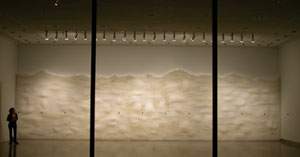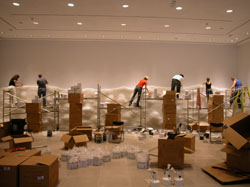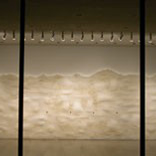At first glance from a distance, Tara Donovan’s aptly titled installation appears to be nothing more than a slightly bulbous, cotton candy cloudscape intent on avoiding definition.
But this distanced view vanishes like a not-too bad dream on closer inspection, becoming a radiant tonal kaleidoscope that is entirely viewer-activated. Fusing micro and macro, Donovan has pushed the practical materialism of the bend-fold-and-mutilate assemblage sculpture of Donald Lipski or Sarah Sze into her own effervescent form of transcendentalism.
Donovan’s hallmark is the transmutation of ubiquitous, mass-produced materials through a series of seemingly endless obsessive actions, and Haze is no exception. Composed of tens of thousands of seven-inch translucent plastic straws stacked one atop the other against the 44-foot long back wall of Rice Gallery, this piece, like much contemporary installation art, succeeds by privileging the viewer’s perspective. Rice Gallery’s installation is a recreation of Donovan’s earlier incarnation of the same work at Ace Gallery in New York, and in that sense her work, like a Sol Lewitt wall drawing, exists primarily as a conceptual idea that can be adapted to suit a particular space: installed, destroyed, and recreated multiple times. And like Lewitt’s installation, the hand of the artist is deemphasized and almost beside the point: anyone can realize the piece if they follow the instructions (as Donovan did, working with a changing roster of student volunteers for 32 hours to assemble her sculpture in Houston). Haze is the first wall-based work to be shown in this installation-oriented gallery in some time; it is also certainly one of the most painterly sculptures ever to inhabit this space.
View in their entirety, so many stacked straws display a stubborn group identity, but the closer you get, the more the veil is pierced and particulars begin to express themselves. You begin to notice that Donovan’s straw wall is irregular, sporting bulges that ripple across the surface of the piece as the stacked straws deviate slightly from the wall’s plumb. Haze’s shifting façade intensifies what you begin to perceive as you move closer to it: dazzling, quickly shifting refractive patterns that are entirely the result of the way the light catches individual straws as you move in front of the piece. This is a piece that rewards locomotion and individual perspective, practically begging you to promenade before it.
Puncturing what at first seems to be a seamless construct, close-up encounters with Haze dispense with fuzziness, asserting the kind of foregrounded narrative details one associates with traditional landscape painting. Haze conjures the specificity of the passenger’s vehicular stare, which can discern one implacably legible row of corn amid the otherwise impenetrable rush of cornfield that surrounds it. But such distinctions between the panning blur of high-speed montage and one resolutely legible image are contradicted and multiplied in Haze, which is both resolutely abstract in its luminous details, and omni-directional in sifting and focusing branching networks of light and shade. The abstractions that emanate from this installation are, like lenticular pictures, mesmerizing and strangely hallucinogenic chimeras that possess the graphic, constantly changing intangibility of animation. Haze shows Donovan at her best: optimistic, fluid, sensate, and willing to risk the equation of vantage point with point of view.
All images appear courtesy the artist and Rice University Art Gallery.
Christopher French is an artist and writer living in Houston.





